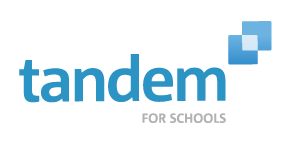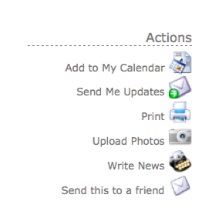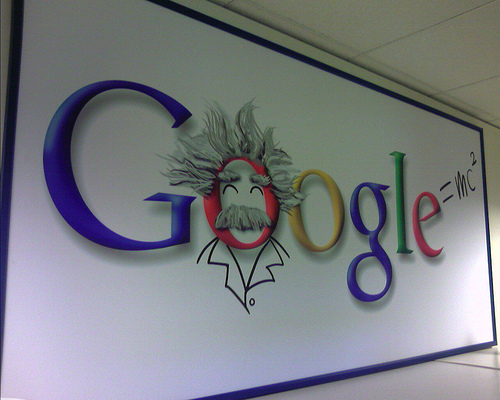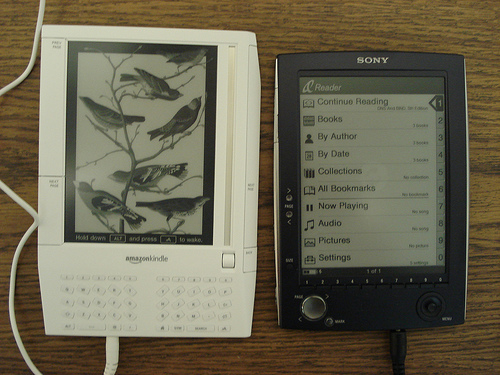Top Resources for Educational Technology News
It can be tough to keep up with all of the news coming out of the educational technology sector. With such rapid changes in social media, computing devices, and best practices it can be tough to stay informed. That is why we have compiled a list of the top resources for education technology.
3. THE Journal
4. Converge
5. EdTech Blog
So, when you want to learn about new technology besides Tandem, be sure to check these sites out!
Thank you to all of our customers for voting Tandem for Schools as a Top 100 Product of 2010! In late August we sent a request to our customers asking them to vote for us and they sure came out in droves. Recognition as a Top 100 Product means a lot to the staff here at Intand and we are extremely grateful that are customers voted for us. You can feel the energy here in the office today!
You can find the entire list of the Top 100 Products on the District Administration website.
Top tweets from last week
When we are not busy building the best online school calendar available, we like to take a look at what others in education technology are working on. Below are a couple of those highlights from last week. To find more articles like these, follow us on Twitter!
One Laptop per Child: This is a great read regarding how far the one laptop per child initiative has come. Can’t wait to see where this goes in the future! http://tiny.cc/ikjhx
Facebook for Teachers: A super-intendent in California has revealed a program aimed at letting Teachers collaborate in an environment similar to Facebook. It allows teachers to create profiles and access a database of teaching resources. http://tiny.cc/g2gji
How To Make A School Calendar Work For You
Technology is an amazing tool, with the capacity to complicate or simplify depending on how it is used. Technology for its own sake can be an expensive distraction, but it is hard to find an argument against switching to online school calendars. Web calendars like Intand’s Tandem for Schools are ideal for achieving simplicity and reducing waste and clutter by streamlining information delivery.
to complicate or simplify depending on how it is used. Technology for its own sake can be an expensive distraction, but it is hard to find an argument against switching to online school calendars. Web calendars like Intand’s Tandem for Schools are ideal for achieving simplicity and reducing waste and clutter by streamlining information delivery.
Navigating modern life is a balancing act, particularly for busy families with working parents often dealing with multiple kids in multiple schools. Multi-tasking is the order of the day for parents, kids, and school staff. Adopting an online school calendar format helps relieve the burden of coordinating school and extracurricular activities, taking some of the stress out of having to mentally juggle mountains of information. Hosted web calendars like Tandem can be accessed by parents at no charge, with only minimal start-up costs for schools, and no need to install software or buy hardware.
A centralized school district calendar provides parents with a one-stop source for vital, up-to-the-minute information. That information may be accessed from the office or wherever internet is available – a real lifesaver for working parents and a vast improvement over old-fashioned paper calendars posted on refrigerators or bulletin boards. Having that information right at their fingertips with updates by text, e-mail, or RSS feed is also a more surefire delivery system than relying on kids to deliver notes or remember a schedule change. Any parent who has ever fielded a frantic last minute call for a forgotten field trip consent form will really appreciate the convenience that Tandem offers.
Using the MyTandem feature students can even set up their own tailor-made calendars to g et updates for groups and activities that they participate in or that interest them. In the process, they will be building essential life and work skills, learning time-management and developing greater responsibility and ownership. At the same time, parents are freed from the thankless role of micro-managing which will help reduce family stress and eliminate the familiar refrain, “but mom, you forgot to remind me!”
et updates for groups and activities that they participate in or that interest them. In the process, they will be building essential life and work skills, learning time-management and developing greater responsibility and ownership. At the same time, parents are freed from the thankless role of micro-managing which will help reduce family stress and eliminate the familiar refrain, “but mom, you forgot to remind me!”
This benefit carries over into the school’s front office, relieving harried staff members of the endless task of taking parent calls about schedules and events. With an online calendar, parents can access answers themselves, and staff will have a central location for information. Busy school personnel will also appreciate the automated e-mail update feature that Tandem for Schools includes to communicate schedule changes and other updates. Contrast this with the time-consuming task of composing, printing, and distributing memos during the course of a hectic school day while trying to beat a 3 p.m. deadline. Online calendars can be updated by designated personnel at any time of the day, night, or weekend. And unlike paper notes that often go unread and forgotten at the bottom of a backpack, this information is guaranteed to be delivered. Communication between parents and schools is too crucial to leave to chance, while miscommunication erodes that relationship; online school calendars help bridge that gap.
![]()
To learn more about what Tandem can do for your school, sign up for a free demonstration or a free 30 day trial.
Don Tapscott On Educating the Net Generation
 Today’s educators, many of them baby boomers, have witnessed the dawn of a digital age as part of a generation whose members developed new technologies with the power to transform the world as we know it. Now, these pioneers are turning over the reins to the next generation. These digital natives are the subject of “Grown Up Digital”, Don Tapscott’s latest book and follow-up to his eye-opening 1998 work “Growing Up Digital”. In this sequel of sorts, Tapscott tracks the several hundred students he interviewed earlier as they are poised to become leaders themselves. These book-ended volumes grew out of a larger study that spanned a dozen countries and included thousands of young people born between 1978 and 1994.
Today’s educators, many of them baby boomers, have witnessed the dawn of a digital age as part of a generation whose members developed new technologies with the power to transform the world as we know it. Now, these pioneers are turning over the reins to the next generation. These digital natives are the subject of “Grown Up Digital”, Don Tapscott’s latest book and follow-up to his eye-opening 1998 work “Growing Up Digital”. In this sequel of sorts, Tapscott tracks the several hundred students he interviewed earlier as they are poised to become leaders themselves. These book-ended volumes grew out of a larger study that spanned a dozen countries and included thousands of young people born between 1978 and 1994.
This generation, with its unique birthright, relates to technology in a dramatically different way than their parents, who often mistakenly equate internet activity to mindless TV viewing and miss an important contrast. Watching television is primarily one-way entertainment, largely deserved of its criticism as a poor substitute and intellectual inferior to reading. Internet, on the other hand, is interactive, particularly for digital natives who utilize it as a tool to connect, communicate, and extend instead of as a mere data dispenser. This Net Generation of multi-tech-taskers approaches technology from a perspective that baby boomers can only imagine, without constraints or predetermined rules of conduct.
The portrait that emerges from Tapscott’s interviews is mostly optimistic. Standing as we are on the precipice of a new age, Tapscott observes that we are at an unprecedented moment in history. Today’s youth uniquely possess a mastery over us adults, their seniors. There is no turning back, no shutting the lid on this Pandora’s box. But instead of envisioning a future of digital dolts and dullards, Tapscott sees the promise of a generation without limits or global boundaries.
At a recent Consortium for School Networking, Tapscott argued that what is needed is not to merely “throw technology into a classroom and hope for good things” but to rethink the purpose of education and the role of teachers. Instead of teachers serving to transfer knowledge to student receptacles, instilling skills for lifelong learning should be the goal. Teachers don’t just need to get out of the way to allow students to make the most of technology’s amazing tools. Educators, he says, ought to be pioneers in the transformation, spending less time on lectures to allow more time for the kind of engaging tasks that prepare students for their important role as stewards of the future.
Source: Tapscott: Digital natives need tech-rich education from eSchool News
Photo by http://www.flickr.com/photos/fernando/ / CC BY-SA 2.0
The Potential of the iPad as a Tool for Classrooms
If the fanfare surrounding the u nveiling of the iPad seemed familiar, it’s because we’ve become accustomed to the parade of products by Apple’s prodigious genius. As innovator of some of the most iconic and ubiquitous tech tool-toys, Apple co-founder Steve Jobs has been hailed as this generation’s Edison.
nveiling of the iPad seemed familiar, it’s because we’ve become accustomed to the parade of products by Apple’s prodigious genius. As innovator of some of the most iconic and ubiquitous tech tool-toys, Apple co-founder Steve Jobs has been hailed as this generation’s Edison.
Portability is one of the iPad’s chief assets, so it’s not hard to imagine the iPad becoming a standard feature in classrooms and backpacks. At a mere pound and a half, with up to 10 hours of battery life and a screen measuring nearly 10” diagonally, the iPad is made for mobility. Simple touch screen navigability and interactivity will appeal to the K-12 set. Having grown up with iPhones and iPods, it won’t be hard for students to make the transition to the iPad.
As a digital media delivery system the iPad has plenty of potential. Publishers are lining up to offer their textbooks as iPad downloads through the iBooks store. But whether the initial cost of the device can be recouped by schools or parents through savings on textbooks will depend on the affordability of those downloads.
Since the iPad utilizes iPhone’s operating system, the device is compatible with iPhone apps- many already in use by teachers- and iPad apps are in development now. But this is also one of its limitations, since it is geared toward Apple app exclusivity.
Some concerns include the iPad’s “virtual keyboard” which isn’t conducive to serious typing. It also fails at multi-tasking because multiple apps aren’t able to be opened simultaneously, limiting the iPad’s use as a convenient research tool.
Still, in many ways the iPad seems tailor made for this generation of students. With its potential to enhance the learning experience through audio, video and touch technology, the iPad holds out the promise of engaging today’s attention-challenged learners. That is, unless it merely adds another layer of distraction. While teachers and consumers will have to wait a little longer until the iPad hits store shelves, some may want to postpone their purchase for the next generation of devices that are sure to follow, or wait to see what Apple’s rivals release in its wake.
 Despite tough economic times, Congress has moved forward in recent times to implement programs that will expand the use of technology in education – from federal stimulus funds that can be applied toward upgrading technology resources in schools to the establishment of a new, federally funded national center focused on developing learning technologies.
Despite tough economic times, Congress has moved forward in recent times to implement programs that will expand the use of technology in education – from federal stimulus funds that can be applied toward upgrading technology resources in schools to the establishment of a new, federally funded national center focused on developing learning technologies.
American Recovery and Reinvestment Act of 2009
Also known as ARRA, the $787 billion federal stimulus package allocated $650 million for Educational Technology State Grants. The goals of the program are to:
(1) Improve student academic achievement through the use of technology in schools
(2) Assist all students in becoming technologically literate by the end of eighth grade
(3) Encourage the effective integration of technology with teacher training and curriculum development in order to identify successful research-based instructional methods.
Funds can be used for acquiring and maintaining hardware, software and connectivity equipment, professional development to enhance technology instruction, developing and implementing information technology education, application of technology resources to improve communication with parents, distance learning, and developing and using technology tools to enhance education.
The program was launched in the fall of 2009 and is expected to run through the 2012 fiscal year.
National Center for Research in Advanced Information and Digital Technologies
“It’s time that education had the equivalent of what the National Science Foundation does for science, Darpa does for the national defense and NIH [National Institute of Health] does for health,” – Lawrence K. Grossman
This new center within the U.S. Department of Education, was originally the 2001 brainchild of Lawrence K. Grossman, former president of NBC News and PBS and Newton N. Minow, the former chairman of the FCC. Nearly a decade later, Congress has finally allocated federal funds for the center, which will focus on awarding grants to organizations to research and develop learning technology. The current budget is $500,000 and the center will also solicit additional funds through private donations. The center is expected to begin awarding grants as early as fall 2010.
Links to article sources:
After 10 Years, Federal Money for Technology in Educatio The New York Times
Enhancing Education Through Technology Recovery Plan Recovery.gov
Image source:
Technology Solutions Aim to Fill Education Gaps
Despite the nation’s commitment to the ideal of universal access to education, our  public schools frequently fall short of meeting the changing needs of students across the spectrum. The “no child left behind” mandate has still let some students slip through the cracks, revealing the structural deficiencies in our public school system. Schools struggle under budget constraints, and even the most dedicated teachers are only human. As it turns out, the one-size-fits-all approach is not the best fit when it comes to instruction since there isn’t just a single learning style that suits every student.
public schools frequently fall short of meeting the changing needs of students across the spectrum. The “no child left behind” mandate has still let some students slip through the cracks, revealing the structural deficiencies in our public school system. Schools struggle under budget constraints, and even the most dedicated teachers are only human. As it turns out, the one-size-fits-all approach is not the best fit when it comes to instruction since there isn’t just a single learning style that suits every student.
New entrepreneurial efforts are answering this need and seizing an opportunity to fill this educational gap with the latest in technology. They aim to provide educational solutions via technological avenues, offering software to supplement brick and mortar school instruction and even operating schools online. Technology offers the hope of bridging skill gaps by customizing instruction to target specific academic needs. And it helps fill the gap in science and math at the teaching level since instructors often lack experiential background in these subjects.
A major force in this new wave of online instruction is Ron Packard, CEO of K12. Inspired by his own futile search for a complete online course to help a daughter struggling with math, Packard devised a business model for a full-fledged web-based school. K12 now provides over 20,000 hours of instructional content covering the full K-12 progression (see story in Forbes). Operating its own web-based school as well as furnishing support to other online schools, K12 serves 70,000 pupils and generates $400 million in revenue.
While K12’s students aren’t a representative sample of the public school population, they all have needs which public schools failed to satisfy. They are students with exceptional talents as well as exceptional needs. Online schools cater to scholar athletes and others who find conventional school schedules conflict with extracurricular passions. In some cases, parents turn to online instruction because they see their own values in conflict with those represented by public school instruction.
Apex Learning is another entrant in this growing field. In operation since 1997, Apex Learning targets poor academic performers who are at risk of becoming part of a growing statistic, the million annual high school drop-outs. In addition to distance instruction courses, Apex Learning markets its programs to public schools, enabling more individualized, computer-focused learning in a regular classroom setting.
Making inroads into the achievement gap, Revolution Prep offers software that helps pinpoint and address concept/skill deficiencies. Its program has been adopted by Los Angeles schools to help struggling high school students pass mandated exit tests.
Confronting the challenges and limitations in our present public school system, technology is helping transform the role of teacher from lecturer to facilitator, and easing the workload on instructors at the same time. Technology provides a workable means of identifying and serving the unique academic needs of diverse students, while freeing teachers from some of the burden of devising and implementing lesson plans, and even filling the gap in subject expertise.
The idea of standardized online curriculum in public schools may strike some as revolutionary. But as weaknesses in the well-intentioned educational policies of the past grow more apparent, the concept seems tailor-made for the future of digital technologies in schools.
At a recent conference on Breakthrough Learning  in the Digital Age, Google co-founder Sergey Brin addressed the increasingly prominent role of technology in schools. Paradoxically a high-school drop-out himself, Brin is part of the search engine monolith’s mission to advance the ideal of universal computer access. Stepping up its involvement in the educational arena, Google has lately supplied schools with its top apps at no charge. But the technology giant’s agenda isn’t all altruism. Google’s growing interest and generosity serve a dual purpose, arming the next generation with the latest tools for success while weaning them on Google’s own brand, thus ensuring a pipeline of future consumers already conversant in the language of the company’s product line.
in the Digital Age, Google co-founder Sergey Brin addressed the increasingly prominent role of technology in schools. Paradoxically a high-school drop-out himself, Brin is part of the search engine monolith’s mission to advance the ideal of universal computer access. Stepping up its involvement in the educational arena, Google has lately supplied schools with its top apps at no charge. But the technology giant’s agenda isn’t all altruism. Google’s growing interest and generosity serve a dual purpose, arming the next generation with the latest tools for success while weaning them on Google’s own brand, thus ensuring a pipeline of future consumers already conversant in the language of the company’s product line.
Brin expressed his conviction that today’s curriculum needs to reflect technology’s expanded role, suggesting that the subject of computer science be given a slot alongside math and English in schools. He promoted the idea of textbook downloads and proposed that students be utilized as tech tutors for younger kids as well as seniors. Students, he suggested, could polish their writing skills as Wikipedia contributors. And Brin was adamant that we could not afford to neglect teachers, insisting that our educators need to be better rewarded.
The proliferation of broadband and the increasing affordability of computer equipment are putting technology within reach of greater numbers with each passing day. Yet even as he foresees a future approaching that ideal of universal access, Brin perceives a downside for students in this digital age, recognizing that expanding horizons can be a humbling, ego-deflating experience. Gaining a global perspective can make one’s own talents seem puny by comparison.
Critics might argue that technology and its availability alone are not the answer to what ails the educational system. Putting laptops in the hands of every student is not enough without the input of dedicated teachers, involved parents, and supportive communities. Children are already wired by nature to learn. Sometimes we just need to get out of the way and remove the barriers to learning.
Providing students with the right tools only makes sense. If Google and its counterparts in the tech sector are eager to help underwrite that effort, our financially strapped schools are sure to welcome the support. However, there needs to be a caveat. Not that long ago, schools across the nation were reconsidering having jumped at the chance to earn a few perks by allowing the big soda companies to stock their products in cafeteria vending machines. Whether by coincidence or consequence, a wave of childhood obesity followed. As we usher in the digital age with the support of giants like Google, schools should take care not to sell out the malleable minds in their charge.
Image source http://www.flickr.com/photos/dannysullivan/ / CC BY 2.0
How To Get Free Digital Books for eBook Readers
The Barnes and Noble Nook Reader, Amazon.com ’s Kindle, and the Sony Daily Edition e-Reader have become valid options for providing books, magazines, and other printed materials to students in school libraries. The new technology behind modern day e-readers and their paper like reading screens currently makes the actual devices somewhat pricey.
’s Kindle, and the Sony Daily Edition e-Reader have become valid options for providing books, magazines, and other printed materials to students in school libraries. The new technology behind modern day e-readers and their paper like reading screens currently makes the actual devices somewhat pricey.
However, the savvy school librarian or teacher can help offset the price of the readers by mining the rich library of free materials that are available for download to the new generation of digital readers. Many of the classic books that are required reading for elementary, junior high, and high school students have public domain versions available for ready download into the e-Reader of choice, and they can be downloaded 100% free of charge.
Free eBooks for the Amazon.com Kindle e-Reader
A quick navigation to the Kindle store section of Amazon allows for an option to view all available Kindle titles. When this option is selected, a drop down menu is available that allows the eBooks to be sorted from price lowest to high which ends up revealing page after page of $0.00 books. Of particular interest to school librarians and teachers will be the reference selections, test prep books, and biography/memoirs of notable persons throughout history.
Free Books for the Sony Daily Edition e-Reader
The Sony Daily Edition e-Reader truly provides a large portion of the world of literature to school students. The public domain books that are available through Google Books can be downloaded to a PC desktop and then placed into Daily Edition. All of these books are free and invaluable. A quick browse through Google Books will bring up familiar favorites and obscure manuscripts that have been archived from university libraries. For students in high school who need multiple source materials for research papers, the Sony Daily Edition e-Reader can be a valuable and near instantaneous method of acquiring facts.
Free Books for the Barnes & Noble Nook e-Reader
Nook has only recently experienced its debut on the consumer market, but it has already made a splash. Along with Nook, Barnes & Noble created a desktop download e-Reader for storage of eBooks and allows “loaning” of books and files to friends through both this download and portable devices which can equate to easy sharing among students. Currently Barnes & Noble offers several free eBooks, including a reference dictionary and classics that are usually required reading in high school. More are sure to come as the device makes a larger impact on the e-Reader market.
All three of the current major e-Readers: Kindle, Sony, and Nook have a variety of free eBooks available for download. Many of these free eBooks are materials any school library can benefit from, and utilizing public domain no-cost versions of classics instead of paying for a contemporary download helps compensate for the price of the actual e-Reader.
Photo credit: http://www.flickr.com/photos/jblyberg/ / CC BY 2.0